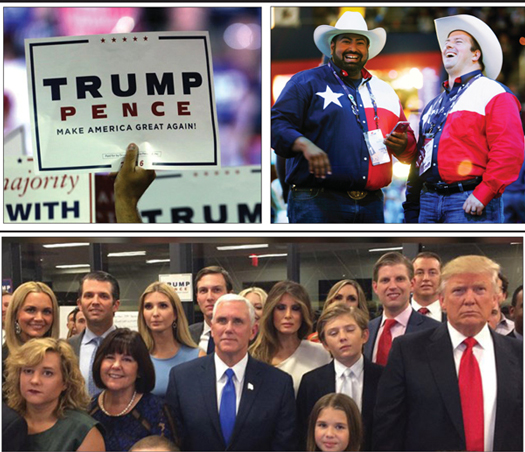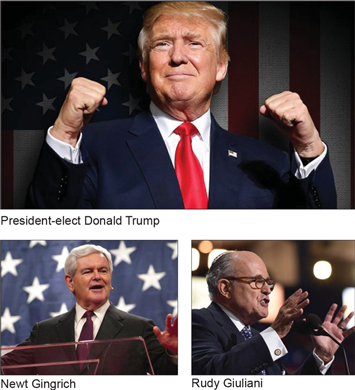One Unchangeable Position: Making America White Again
By Final Call News | Last updated: Nov 16, 2016 - 11:28:41 AMWhat's your opinion on this article?

|

|
After a stunning and historic political upset, President-elect Donald Trump is moving forward to lead the nation. With his first televised interview and some subdued communication with President Barack Obama, the new chairman of America, Inc. is sounding a little different from the bombastic man who thrashed his way to the White House.
The Trump victory, earned by winning 290 electoral votes while losing the popular vote, has seen the president-elect and some surrogates pulling back from some signature campaign themes and promises. Among the pullbacks or detours are eviscerating Obamacare—the war cry of the GOP and Mr. Trump. Such language has been replaced by talk of fixes à la Hillary Clinton as opposed to destroying it. Second, building that wall on the border with Mexico and having Mexico pay for it. Not so fast, the president-elect told 60 Minutes, agreeing the wall could be a fence in some places. The first priority would be securing the borders, then looking at building the wall itself, said the president-elect. Newt Gingrich, a GOP Trump backer, said, “He’ll spend a lot of time controlling the border. He may not spend very much time trying to get Mexico to pay for it, but it was a great campaign device.”
Trump backer Rudy Giuliani told the media the wall will be built because Mr. Trump promised but other things, like tax reform and jobs creation, would take priority in the first 100 days of the Trump administration.

|
Mr. Trump paid more respect to Mr. Obama, whose U.S. citizenship he challenged as leader of the birther movement, following a White House visit than some supporters may have expected.
He vowed to phase out the use of lobbyists, when asked about lobbyists on his transition team, which was a little different from his signature “drain the swamp” refrain—a promise to get money and influence peddling out of U.S. politics.
Some argued mainstream media had taken Mr. Trump literally while his followers were more pragmatic and believed he would deliver on his promises to make change—even if it didn’t start right away. Others argued the Trump moves were a natural part of going from campaigning to actually governing, which could take a little more nuance, patience and negotiation.
There may be some truth to all of the analysis, but there is one plank in the Trump platform and campaign playbook that cannot be denied or softened: The embrace of Whiteness and the fears and concerns of disaffected Whites.
Mr. Trump looked into a 60 Minutes camera and called for an end to any racial assault and hatred coming out of the divisive campaign. But what he didn’t do was admit the deep fear that exists and how divided the country is across racial and other lines. In the 60 Minutes interview he denied hearing much about the anti-Trump protests, post-election violence and racist acts targeting non-Whites across the country. He again placed part of the blame for demonstrations on professional protestors paid to make him look bad.
Trump surrogates echoed that same script. They were unwilling to acknowledge how Mr. Trump’s rhetoric against immigrants, against Mexicans, against Muslims, promises to pay legal expenses for anyone knocking out a protestor at one rally, misogynistic comments and charges of sexual assaults had helped push the country to the edge.
But such rhetoric freed the Whites who gave him victories, by small margins in the battleground states, and ushered him into the White House.
His biggest nod to White victimology and White suffering was the appointment of Steve Bannon, who served as an important campaign aide and anti-GOP establishment voice, as his chief strategist. Mr. Bannon’s appointment was announced alongside the naming of his new chief of staff, former Republican National Committee Chair Reince Preibus.
The Washington Post reported “Bannon and Breitbart were credited with honing Trump’s message against globalism, and unleashing his say-anything approach to talking about terror and immigrant crime.”
The New York Times noted “a chorus of critics took to Twitter to lament what they said was a frightening normalization of the fringe views that Mr. Bannon promoted as the chairman of Breitbart News. The site has for years given voice to anti-Semitic, racist and white nationalist ideology.
“The Council on American-Islamic Relations said Mr. Bannon’s selection ‘sends the disturbing message that anti-Muslim conspiracy theories and white nationalist ideology will be welcome in the White House.’ ”
“The racist, fascist extreme right is represented footsteps from the Oval Office,” said John Weaver, a Republican strategist who ran the presidential campaign of Gov. John R. Kasich of Ohio and previously advised Senator John McCain of Arizona, in the Times piece. “Be very vigilant, America.”
Ana Navarro, a Republican strategist and anti-Trump voiced, tweeted: “Oh, hell! White supremacist, anti gay, anti Semite, vindictive, scary-ass dude named Senior Strategist. After vomiting, be afraid, America.”
“The appointment of Steve Bannon to a senior position within the White House does very little in the interest of healing our country following months of contentious campaign rhetoric from President-elect Trump. Bannon’s appointment is a cold slap in the face to those of us who are working to mend race relations in America, and it further divides our country along the lines of hate and bigotry,” said Congressional Black Caucus Chairman G. K. Butterfield (D-N.C.). “President-elect Trump must work to bring us together and his appointment of Steve Bannon sends an alarming signal that he remains loyal to the animosity and hatred that was the core of his campaign.”
The other issues are negotiable and there is room to change and morph. What Mr. Trump cannot afford to do is to alienate or deny the White malaise that swept him into office. They want one thing: Make America White again. Then, they believe, everything else will fall into place.
INSIDE STORIES AND REVIEWS
-
-
About Harriett ... and the Negro Hollywood Road Show
By Rabiah Muhammad, Guest Columnist » Full Story -
Skepticism greets Jay-Z, NFL talk of inspiring change
By Bryan 18X Crawford and Richard B. Muhammad The Final Call Newspaper @TheFinalCall » Full Story -
The painful problem of Black girls and suicide
By Charlene Muhammad -National Correspondent- » Full Story -
Exploitation of Innocence - Report: Perceptions, policies hurting Black girls
By Charlene Muhammad -National Correspondent- » Full Story -
Big Ballin: Big ideas fuel a father’s Big Baller Brand and brash business sense
By Bryan Crawford -Contributing Writer- » Full Story






 Click Here Stay Connected!
Click Here Stay Connected!








